Viewfinder Screens
The manual focus screen used to be a standard camera part in the last century. But when auto-focus (AF) became wide spread at the end of the century, manufacturers replaced the traditional manual focus screens with new AF screens.
Typically, the AF screens Show AF marks for the specific camera (see picture below). Other than showing a blurry or a sharp image frame, the AF screen does little to aid manual focus. With variation in our eyes, weather, temperature, and optics, what looks sharp or blurry in the viewfinder may just be an illusion. This is not a big deal for most consumers and photographers, because AF works extremely well.
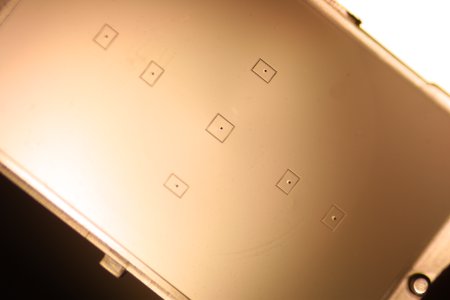
The auto-focus focusing screen from a Canon EOS Digital Rebel camera.
However, in many situations, AF is practically useless. One, tilt-and-shift lenses are only available in manual focus. When you use a tilt-shift lens to shoot architecture or for creative imaging, you can't depend on the trusty AF mode. Two, AF doesn't work well for macro. Macro equipment (extension tubes, bellows, and macro lenses) all introduce heavy light-loss while focusing closely to your subject. The light-loss causes AF To fail completely. When AF does work in lowlight, it works slowly and is spotty at best. Three, when you shoot night scenes or astrophotography, you'll need to manual focus for the same reason just mentioned. Four, telescopes does not AF on your camera. Five, when you use lenses from another camera system on your camera, AF will not work. For example, Nikon lenses mounted on Canon EOS Camera, with Novoflex EOSNIk adapter, will not auto-focus.
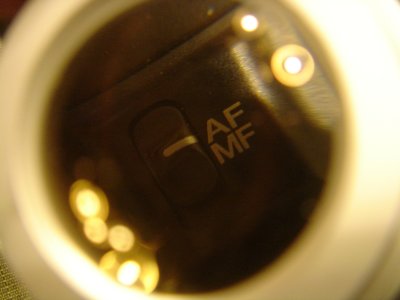
For most AF cameras, you can do nothing more than using your best judgment with the AF screen. For many professional high-end SLR cameras, such as the Canon EOS 1Ds, you can get interchangeable focus screens to help you focus manually or compose your frame accurately. The following sections give you an overview of different types of viewfinder screens.
Microprism
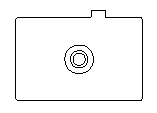
Microprism focusing screen gets its name from placing many tiny prisms on the focusing screen. When the subject is not in focus, the tiny prisms show up in black and white dotted pattern. When the subject is in focus, the prisms blend in with the surrounding light so that you don't see them any more. Although this system still forces you to look closely at the screen, it makes the task slightly easier.
Split-Image
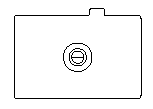
The split-image focusing screen is probably one of the most useful manual focusing screens. A split-image focusing screen has a split circle in the middle. Usually the split is Horizontal. But there are vertical and diagonal focusing screens out there as well. In fact, for some camera systems, there is a "cross-split" type that has both vertical and horizontal splits.
The split divides your image in half. If your subject is not in focus, the two images does not line up. With the horizontal split, one half of the circle is shifted to the left, while the other half is shifted to the right. By aiming the circle on your subject's edge, it is very easy to see whether the edges line up. Instead of looking at whether the image is blurry, adjust the focus until the edge lines up, then you'll know the subject is sharp.
Grid
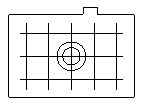
Although most of this article talked about manual focus screens, there are several viewfinder screens used for other purposes. One such screen is the grid screen. The grid screen has several horizontal and vertical lines on it. These lines form a grid. The grid is very useful for composing the scene. You can easily see if an object is on a line, off a line, or at the intersection of a line. It's easy to put things where specified by the rule of thirds. You can see if straight lines are truly vertical or horizontal in the image frame. Architecture photographers find the grid screen particularly convenient.
Scale
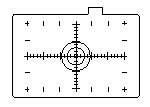
The scale screen is very similar to the grid screen. But instead of forming a grid, the lines on the viewfinder screen form a graph-like scale with the origin in the center of the screen. The scale could be in millimeters, inches, or any other measurement unit. The scale screen is particular useful for macro and scientific photography where the amount of magnification is significant.
What about low-end SLR cameras?
Most low-end consumer SLR cameras do not have interchangeable focus screens. Even if the screens are easy to disassemble on the low-end SLR cameras, camera manufacturers generally will not produce interchangeable screens for them due to the lack of market.
However, recently, several independent vendors have started marketing manual focus screens for the low-end Canon digital SLR cameras, such as the Canon EOS D30, D60, 10D, 20D, Digital Rebel, and Digital Rebel XT. In fact, we will be reviewing the Haoda Split-Image/Microprism Focusing Screen for the Digital Rebel on this web site shortly.
Look around; there might be a focus screen for your camera after all.
Related Links
- Haoda Fu Focusing Screen Review
- Haoda Optical Research Group
- Haoda's Split Image Focusing Screen for the Canon 20D
- Installing a Canon EF-M split-circle viewfinder screen into an EOS camera.
Canon Screens
- Canon EC-1Ds Focusing Screen Black Mask for EOS 1Ds Mark II - Amazon User Reviews
- Canon EC-1Ds Focusing Screen Crop Lines for EOS 1Ds Mark II - Amazon User Reviews
- Canon EC-B New Split Focusing Screen for EOS-1/1N/1V, EOS-3, D2000 & 1D Cameras - Amazon User Reviews
- Canon EC-D Laser Matte with Grid Focusing Screen for EOS-1/1N/1V, EOS-3, D2000 & 1D Cameras - Amazon User Reviews
- Canon EC-I Laser Matte with Double Cross Hair Reticle Focusing Screen for EOS-1/1N/1V, EOS-3, D2000 & 1D Cameras - Amazon User Reviews
- Canon EC-L Cross Split Image Focusing Screen for EOS-1/1N/1V, EOS-3, D2000 & 1D Cameras - Amazon User Reviews
- Canon Ec-S Focusing Screen for EOS-1D Mark II N Digital SLR Camera - Amazon User Reviews
- Canon Ee Focusing Screen Black Mask for EOS 5D Digital SLR - Amazon User Reviews
- Canon Ee Focusing Screen Crop Lines for EOS 5D Digital SLR - Amazon User Reviews
FijiFilm Screens
- Fujifilm Focusing Screen E with Composition Lines for 6x6 Format, for the GX-680 Medium Format Camera. - Amazon User Reviews
Leica Screens
- Leica Focusing Screen, Ground Glass Matte for R8/R9 SLR Cameras - Amazon User Reviews
Nikon Screens
- Nikon F6 Focusing Screen Type A: Matte Fresnel field with split-image rangefinder and microprism collar. - Amazon User Reviews
- Nikon F6 Focusing Screen Type E: Grid lines for accurate picture composition of architectural subjects. - Amazon User Reviews
- Nikon F6 Focusing Screen Type L: Matte Fresnel Field with 45� Angle Split-image Rangefinder and Microprism Collar. - Amazon User Reviews
- Nikon F6 Focusing Screen Type M - Amazon User Reviews
- Nikon F6 Focusing Screen Type U: For lenses with focal lengths longer than 200mm - Amazon User Reviews
Mamiya Screens
- Mamiya RB67 Focusing Screen #6 45 Degree Split Image - Amazon User Reviews
- Mamiya Type E Rangefinder Spot/Microprism Focusing Screen 645 Pro #211344 - Amazon User Reviews
Olympus Screens
- Olympus FS-1 Standard Focusing Screen - Amazon User Reviews
- Olympus FS-2 Grid Focusing Screen (6x8 Grid) - Amazon User Reviews
- Olympus OM System Focusing Screen - Amazon User Reviews
214 Users Online
|
$10000-above $5000-$9999 $2000-$4999 $1000-$1999 $500-$999 $200-$499 $100-$199 $50-$99 $25-$49 $0-$24 Gift Certificate |
|


